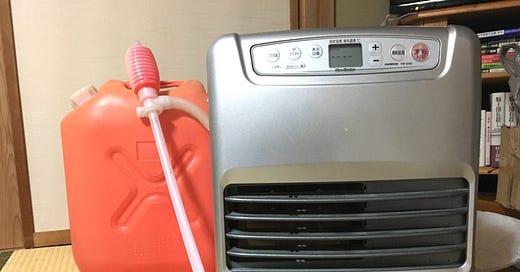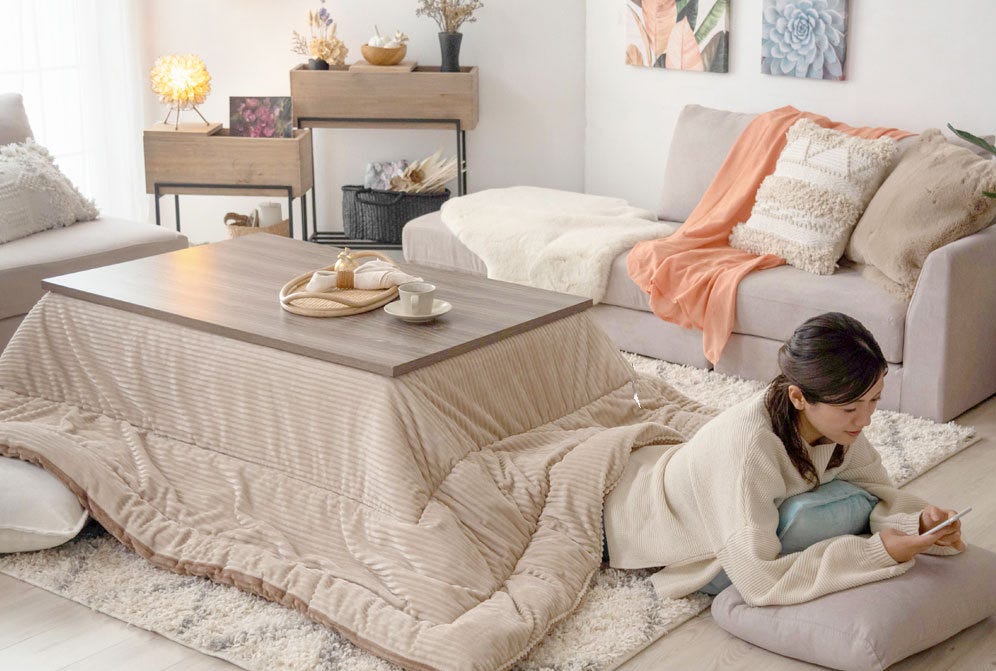Hi there, how are you doing? Are you surviving the summer? In Japan, we still have to wear a mask and boy, I can barely breathe with that thing on.
In my last missive, I had resorted to writing about one particularly cold winter in order to fight the stifling heat. And here I am again, though this time, the subject - lack of adequate insulation in many Japanese houses - pertains to both winter and summer.
As usual, I look forward to your feedback. I know that not everybody agrees with me on this topic…
Question: What am I doing outside my home at 6:00 a.m. with a gas can, a pump, and stalactites under my nose?
Answer: I’m swearing.
I know, this is not a real answer, but at zero degrees Celsius my brain has the tendency to freeze. Wait a second; I’m going back in now…
According to some people, Japan is already living in the future. I beg to differ. While Japan is a technological giant and our rabbit hutch-like houses are bursting with the latest electronic gadgets, the quality of life in this country could be much better if we enjoyed the same basic services people take for granted in the West. Even in Italy – where I come from – the seemingly never-ending economic recession rarely prevents many people from enjoying rather high living standards. Japan, on the contrary, is still the third economic world superpower, but all too often its people seem to lead a relatively poor life.
Take house heating: In Italy most houses have central heating; here, on the contrary, so-called “space heating” is the norm – which does not mean we are living in the Space Age, but rather in the Stone Age.
Space heating, or – as I prefer to call it – “tactical heating,” consists in heating only the room where you spend most of the time i.e. the living room, while living the rest of the house in the cold. This, of course, cannot but cause some collateral damage, like: 1) when you go to bed and slide under the ice-cold sheets, you suffer hypothermic shock and risk dying of exposure (anybody remembers the movie The Red Tent?); and 2) when you have to answer the call of nature in the middle of the night, you have to put on the coat. Now you see why the Japanese have invented the WC with the heated seat.
On the plus side, the entry hall is so cold that it can be used (and it is actually used) as a refrigerator to store such things as fruits and vegetables.
Japan is still the third economic world superpower, but all too often its people seem to lead a relatively poor life.
Tactical heating used to be organized around the infamous kotatsu, a piece of furniture that only the Japanese – those masters of thriftiness and simplicity – could invent. As many people know, it is a low table covered with a quilt, and with a small electric heater screwed to its underside. People of the house used to slip their legs under the table, covering the lower body with the quilt, and spending the night watching TV, eating tangerines and getting drunk. There was always someone who inevitably fell asleep, with the upper body in the open, and woke up the day after with the usual stalactites under the nose, a nasty headache, and a nice cold.
The infamous kotatsu
First invented during the Muromachi Period (14th century), the kotatsu is still going strong among the Japanese (and those weird foreigners who either can’t afford something better or have a mistaken idea of what “embracing Japan” actually means) but there are now trendier (though only slightly better) ways to keep warm.
I guess that most people now use an air conditioner, but apart from consuming an awful lot of electricity, it’s often quite inefficient in our non-insulated houses; turns our throats into sandpaper; and it’s lethal to people who are allergic to dust.
Another popular heating tool among the horizontally inclined is the electric carpet, a seemingly innocuous thing that lulls its preys into a warm (probably drunk) torpor while exposing them to 130-160 milligauss-worth of electromagnetic waves.
According to architectural adviser Ashizawa Keiji (who was interviewed on the subject by Japan Times columnist Jean Snow for uber trendy website neojaponisme), “Only in Hokkaido is there such a thing as the Law on Cold Residences, and the Government Housing Loan Corporation gives financial assistance to homes protected against the cold. They say that people from Hokkaido catch colds when they come to Tokyo, because they traditionally live in houses insulated and warmed through central heating.”
For those who don’t live in Hokkaido, the most effective piece of technology out there seems to be the kerosene heater – which, when you think about it, is the best solution, especially when you live in a highly inflammable wooden prefab house.
The advantage of living in a poorly insulated house in winter is that the entry hall is so cold that it can be used (and it is actually used) as a refrigerator to store such things as fruits and vegetables.
And here we can finally go back to my story: What the hell am I doing outside my home at six in the morning? Why, I’m filling the gas can, of course!
“And why didn’t you do it the day before?” I’m sure you will ask.
Alright, let’s check the videotape...
22:00, the day before: the stove goes beep-beep and the magic number 50 flashes on the screen, which means only 50 minutes worth of kerosene is left. I’ve just come back home and I’m dead tired. So I look at the clock, look at my wife, then look at the stove and say: “Let’s switch this off and use the electric stove, so we have enough fuel for tomorrow morning.” The Boss says nothing, which means she doesn’t dislike my idea.
5:45, today: I’m woken up by the Boss screaming and railing against Buddha, Confucius and especially against me.
“I told you to put the kerosene in!!!”
“???”
“Now only 10 minutes are left... You know, this stove sometimes does such tricks.”
“Bloody tricks!” says I.
“Okay, you go back to sleep... I’ll manage somehow...”
This is obviously a trap. I used to fall for it in the past, but now she doesn’t fool me anymore. As soon as I hear those words I jump out of bed, get dressed in a hurry, and go out to fill the gas can.
Early to bed, early to rise, makes a man healthy, wealthy and wise... and smelling of kerosene.
Not only the Japanese house often fails to protect us from the cold, the place itself can be dangerous for our health, and I’m not talking about earthquakes. Many buildings, in fact, are affected by so-called Sick House Syndrome. A “sick house” is a house which causes health problems such as allergies, atopic dermatitis and respiratory problems due to the emission of synthetic chemical materials (e.g. formaldehyde, asbestos) that until a few years ago were liberally used in construction. Sick Building Syndrome, as it is called in other countries, is not only a Japanese problem, but it seems that abroad the health hazards are mainly due to natural causes, like molds, algae, particles, etc. while in Japan it is often a man-made problem.
Sick House Syndrome causes health problems such as allergies, atopic dermatitis and respiratory problems due to the emission of synthetic chemical materials (e.g. formaldehyde, asbestos).
Another thing that always makes me scratch my head are those huge gas cylinders they have chained on the side of my house. In order to save a few pennies, on installation expenses, my wife decided to use propane gas instead of the more convenient and ultimately cheaper Tokyo Gas.
This means that each family gets a couple of tall fat cylinders the moment they move into a new house. The cylinders are literally chained to the wall, periodically checked, and replaced once they run empty. The gas guy assured me that they are safe, and even in case of explosion our house would not be damaged. Still, they look like a couple of bombs to me.
What really left me speechless the first time I saw it is communal sewer cleaning. I’m sure (I hope) that many of you who are lucky enough to live in less backward areas have never heard about it, but in some places you are expected to join your neighbors once a year and actually get dirty and clean the local sewer. It’s not only a disgusting thing to do; I thought that all the local taxes we pay covered at least this kind of service.
And how about uchimizu, the summer custom of sprinkling water in the street in order to cool the area? My friends back in Italy saw it on You Tube and asked me why they don’t just go around with a tank truck. Well, first of all, a tank truck is just too big for the narrow residential street where I live.
Also, and most importantly, my friends missed its real meaning, the amused obasan who lives near my house told me. Why, such customs as uchimizu and sewer cleaning bring out our national values as they combine utilitarian, courteous and dutiful ends. Take that, you selfish gaijin!
Back to heating, after years of trying to survive the Japanese winter I found a couple of simple ways to put tactical heating into practice and keep my blood from freezing solid. The first one is putting on several layers of cloths until I start resembling Bibendum, the cute Michelin Man. I usually opt for a t-shirt/wool underwear/pajama/tracksuit/hooded sweatshirt combo. Plus two pairs of socks, of course.
Another winner is putting in your bed – between the sheets and the mattress – an insulating sheet – the one that looks like thick aluminum foil. That really works miracles, I guarantee. Now I can finally enjoy reading in bed again – even though my hands become numb after a while. My favorite books recently are Antony Beevor’s histories, especially Stalingrad and its sequel, Berlin: The Downfall 1945. Reading about all those frostbitten soldiers crossing the steppes at 30 degrees Celsius below zero makes me feel that here in Japan we don’t have it so bad after all.
As usual, if you liked this piece, please share it widely. You will earn good karma points.
And you may even want to subscribe. It’s FREE.





